Woodville Road – one of western Sydney’s main north-south links running from Parramatta to Villawood – doesn’t exactly scream liveability.
Called Dog Trap Road when built in 1816, it used to be known for wild dogs, bushrangers and a rough pub called Lackey’s. Some would say it’s not much better today.
With six lanes of noisy, polluting traffic and an abundance of fast-food chains and petrol stations, it typifies some of Sydney’s major arterial roads like Parramatta, King Georges or Silverwater.
But Cumberland Council has major plans to renew and revitalise four kilometres of the highway, from Granville to Guildford, by rezoning it for more than 3500 new dwellings, along with mini-parks, trees and cycleways.
“Let’s just say whenever I have to go down Woodville Road, I always give myself plenty of time,” Mayor Lisa Lake says, diplomatically, of the much-maligned thoroughfare. “It is a road that has existed for a very long time, and it needs a bit of love.”
It was a slow process. The Woodville Road corridor was earmarked for revitalisation in 2015 by Parramatta Council before a boundary change transferred the area to Cumberland. In 2021, that council submitted the first iteration of this plan to the Planning Department, which suggested several changes to building heights and floor space ratios to make development more feasible.
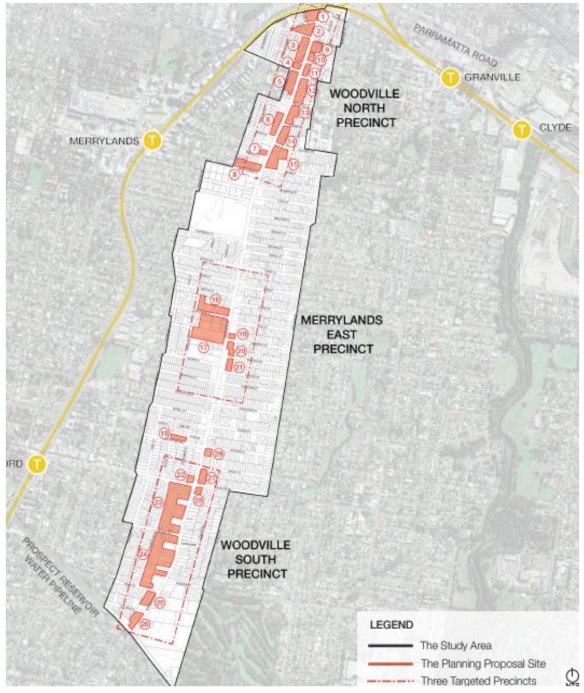
The Cumberland Council plan earmarks three precincts for a collective 3700 new homes along a four kilometre corridor of Woodville Road.Credit: Cumberland Council documents
That triggered a new round of analysis and technical studies. The new version passed council last month and now goes back to the department for what is known as a “gateway determination”. If successful, it will go back on public exhibition.
The latest plan envisages 3696 new dwellings over three precincts along Woodville Road, in buildings up to 41 metres or 12 storeys. It projects 3875 new residents in the northern precinct, 2306 in the middle Merrylands East section and 4168 in the southern precinct.
If realised, the Woodville Road corridor population would increase by more than 80 per cent.
The package of documents endorsed by the council includes a public domain plan for open space, trees, street furniture, lighting and public art, to transform the congested road into a “tree-lined boulevard”.
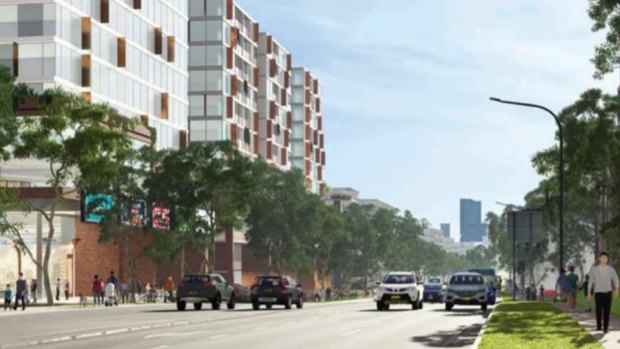
An artist’s impression of how Cumberland Council thinks the Woodville Road of the future will look.Credit: Cumberland Council documents
But can anything make this highway liveable? Lake hopes that through good design, with 10-metre setbacks from the road, the answer is yes. “With Sydney how it is with housing, I think people are looking for homes that are safe and secure and well-connected,” she says.
“Woodville Road is a place that’s fairly central, not far to major workplaces. If the rents and the prices are pitched at the right level, then I think people will find them attractive in that way.”
But not everyone agrees. The issue is divisive even among those leading the YIMBY, or Yes In My Backyard, push for more housing density. A co-founder of Sydney YIMBY, Justin Simon, says plonking apartments on major arterial roads is bad planning aimed at minimising neighbours’ objections.
“You can’t open your windows at night because it’s too loud. If you have asthma, it ends up being almost a dealbreaker,” Simon says. “More housing is better than no housing, but it should be one block back from the main road at least. That means better outcomes for everyone.”
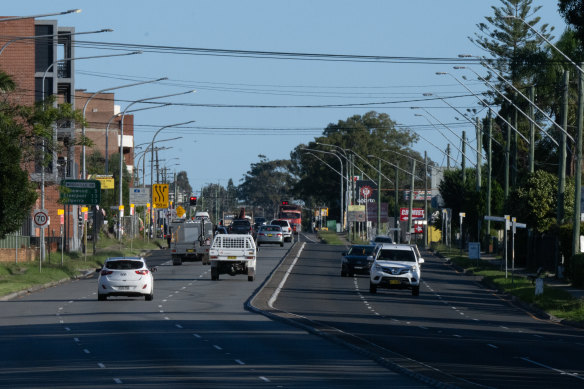
Some development has already taken place along Woodville Road, but the new controls would allow for much more.Credit: Nick Moir
Business Western Sydney executive director David Borger, a former Labor housing minister, said it was good to arrange housing density along corridors. The real transformation of Sydney’s arterial highways would occur when electric vehicles became more widespread, he said.
Borger, who is also involved in the YIMBY movement and chairs the lobby group Housing Now, acknowledged the drawbacks of living on or near major roads. But he said, “There’s got to be a few cheap seats in Sydney, or people get locked out. These are affordable starting points for some people, and why shouldn’t we have more of those?”
This part of Sydney is already starting from behind. The draft strategy says Guildford East has a youth disengagement rate of 19 per cent, and in 2016, 18.5 per cent of households did not have internet access.
The Woodville Road corridor is diverse: half the people living there were born overseas. But “the corridor’s population is ageing and generally has poorer health outcomes compared to the rest of the Cumberland population”, the strategy notes.
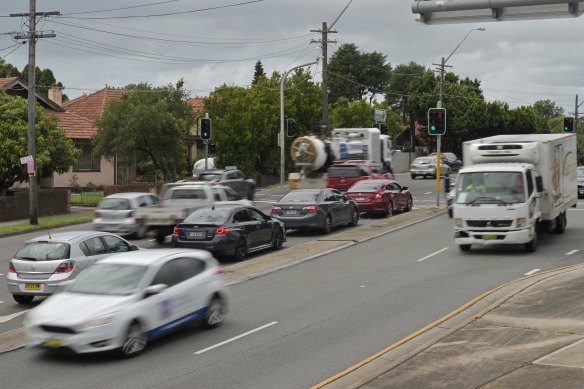
Parramatta Road is perhaps Sydney’s most hated road.Credit: Nick Moir
The planning process so far has been long and laborious, and Lake says there is still “a long way to go” before any changes are actually made. But it pales in comparison to the paralysis engulfing Parramatta Road, perhaps Sydney’s most hated highway.
In 2016, the state government published the Parramatta Road Corridor Urban Transformation Strategy (PRCUTS), which was supposed to guide the revitalisation of the 20-kilometre road from Camperdown to Granville.
It promised to create 27,000 new homes and 50,000 new jobs in the corridor over 30 years, and committed to an “on-street rapid transit system”, i.e. a tram, from Burwood to the Sydney CBD.
However, work was “put on hold” while traffic studies were conducted. They were still under way when an implementation update was issued by the NSW government in July 2021.
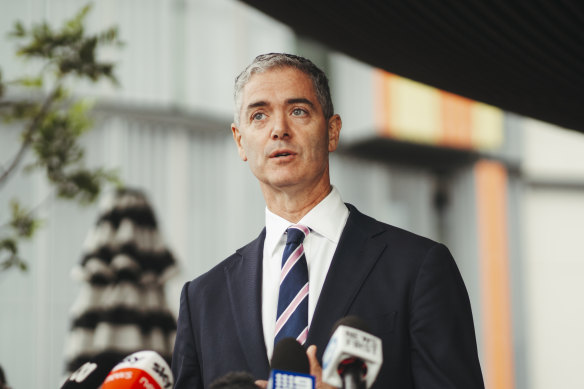
Roads Minister John Graham intervened to stop the widening of Parramatta Road.Credit: Dion Georgopoulos
Inner West Council recently completed planning proposals for three mini-precincts along the Parramatta Road corridor: Leichhardt, Taverners Hill, and Kings Bay/Croydon. These precincts have the combined capacity for about 1500 new homes. (The original PRCUTS envisaged 9240 dwellings at those three precincts.)
However, Transport for NSW’s feedback – namely, that the road would need widening to accommodate the future transit system – stunned the council and led Roads Minister John Graham to intervene and rule out expanding the road.
The skirmish has further delayed the modest planning changes designed to encourage additional housing along the corridor.
Simon said he was “pretty sceptical” that anything would actually get built because the small uplift in building heights allowed by the council – as well as myriad rules about construction materials and design – would make potential projects financially unviable.
Both the Woodville and Parramatta road cases highlight how the state’s planning system involves complex, time-consuming and costly processes that bounce back and forth between councils and the state government.
Last year, Planning Department secretary Kiersten Fishburn told the Herald it was a waste of time for her department to undertake gateway determinations for every council planning proposal. “If it’s consistent with [their] own strategic plan, why are we marking their homework?” she said.
The department did not answer questions about whether Woodville Road was an example of the kind of double-up Fishburn was against. It said it had not received the plan from Cumberland Council, but once that happened, the benchmark assessment time was 45 days.
Start the day with a summary of the day’s most important and interesting stories, analysis and insights. Sign up for our Morning Edition newsletter.